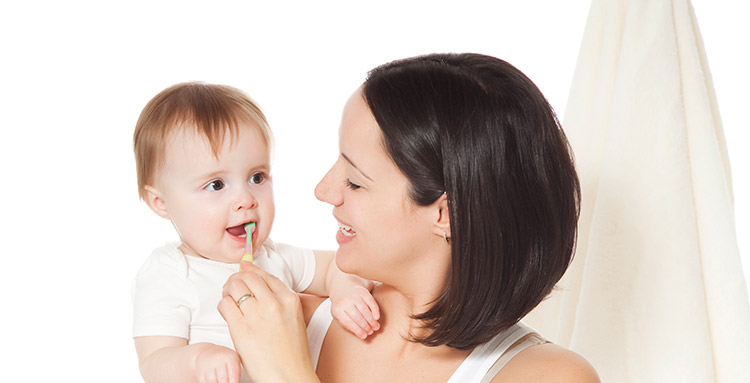Caring for Your Baby's Teeth and Gums

Summary
Table of Contents

This blog has been reviewed and approved by Dr Robert Lee, a dental professional of 35 years
LEARN MORE >Good oral care starts early, even before that first baby tooth erupts! Here’s how to brush baby teeth, how to care for tender gums, and the age-appropriate toothbrushes and toothpastes that can help keep their growing smiles healthy.
Taking Care of Your Baby's Gums
Caring for a healthy smile starts from birth. To help prevent the buildup of plaque bacteria that can lead to cavities, pediatric dentists and pediatricians highly recommend regularly cleaning your newborn’s gums with a damp washcloth following feedings.
Here’s how to clean baby’s gums:
- Moisten a clean washcloth with water.
- Wrap the washcloth around your index finger.
- Gently massage the gums,
In addition, take measures to prevent baby bottle tooth decay, a disease that occurs in 15% of children and causes severe, swift decay of baby teeth.
To help prevent it, do not put your baby to bed with a bottle of formula or a sugary drink, such as juice. The possibility of tooth decay is directly related to the number of times that sweet things are in contact with the teeth (formula contains some sugar).
HOW TO BRUSH BABY TEETH
Around four months, a child usually begins to teethe. When the first tooth comes in through, it’s time to start brushing. Since baby teeth impact the alignment of adult teeth, it’s important to properly brush and floss them.
- Dab a pea-sized amount of fluoride-free toothpaste onto an extra-soft bristled toothbrush then gently clean the baby’s gums and teeth.
- Brush their teeth for two minutes, twice a day to help prevent decay and to help get your baby used to the recommended brushing time.
- Make sure to set up a dentist appointment once that first tooth makes its debut. Cavities, gingivitis and tooth decay are common problems associated with your child’s growing teeth.
WHEN SHOULD I START BRUSHING BABY TEETH WITH TOOTHPASTE?
According to the American Academy of Pediatric Dentistry, the sooner you start brushing baby teeth with toothpaste the better. Once their first tooth erupts, you can start brushing with a tiny smear of toothpaste twice a day. Once they reach 3 years old, you should start using a pea-size amount of fluoride toothpaste to better prevent cavities and strengthen their smile.
DO BABIES NEED A SPECIAL TOOTHBRUSH AND TOOTHPASTE?
Just as developing children require special attention, so do their teeth. When it comes to your baby, if you want to start training for using toothpaste in the future look for a cleanser that’s safe to swallow, fluoride-free and doesn’t contain artificial colors or preservatives. A fruity flavor helps too. The Oral-B and Crest Baby Training Toothpaste and Toothbrush Kit features a mild strawberry flavored toothpaste that's free of artificial flavors, sodium lauryl sulfate, sweeteners, and dyes and a manual toothbrush with extra-soft bristles for a gentle clean.
As their smiles develop, look for products designed to meet a child’s needs at different stages, taking the following into consideration:
- Extra-soft bristled toothbrushes to gently clean baby teeth and tender gums.
- Small-sized brush head for a more comfortable fit.
- Ergonomic handles specially designed to make it easy to brush baby’s teeth.
Table of Contents
- Taking Care of Your Baby's Gums
- How to brush Baby teeth
- When should I start brushing baby teeth with toothpaste?
- Do Babies need a special toothbrush and toothpaste?
-
- Sources

This blog has been reviewed and approved by Dr Robert Lee, a dental professional of 35 years
LEARN MORE >
Sign Up
for expert advice and exclusive offers



